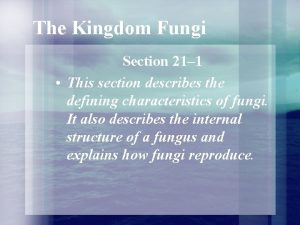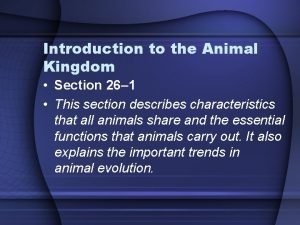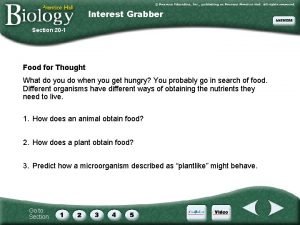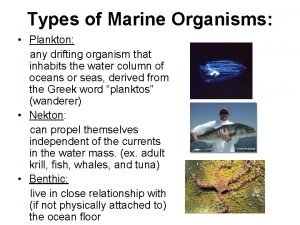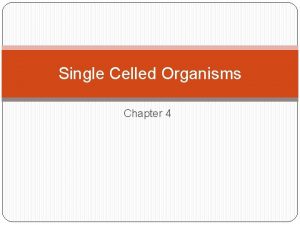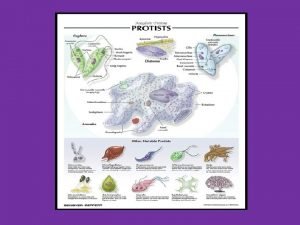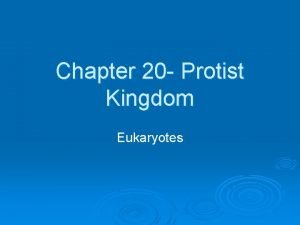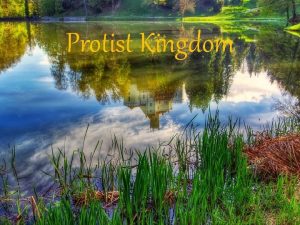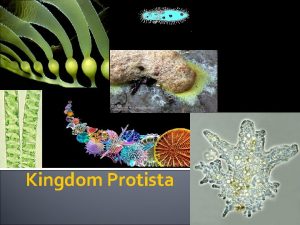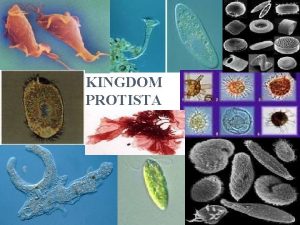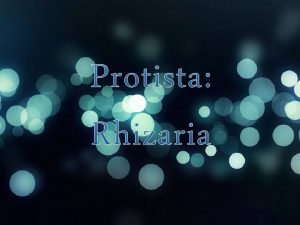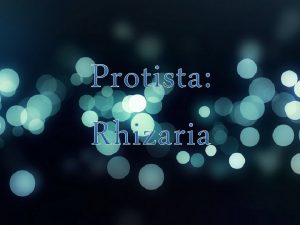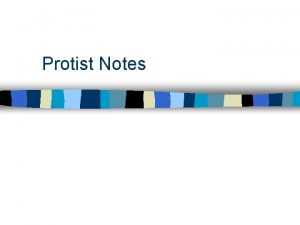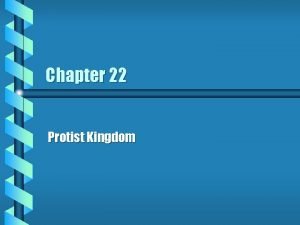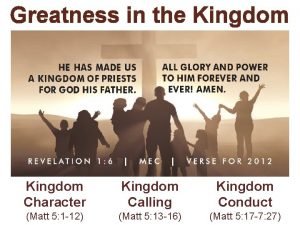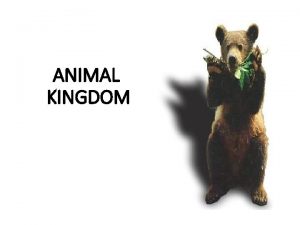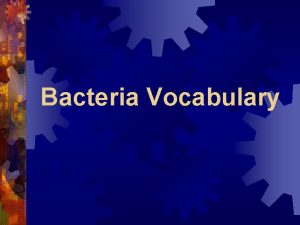CHAPTER 8 SECTION 1 PROTIST PROTIST KINGDOM AS















- Slides: 15

CHAPTER 8 SECTION 1 PROTIST

PROTIST KINGDOM AS DIFFERENT AS THEY APPEAR, ALL OF THESE ORGANISMS BELONG TO ONE KINGDOM. -

Protist- kingdom of organisms that are one or many-celled, live in moist or wet surroundings, are eurkaryotioc (have a nucleus and organelles). - All protists have eukaryotic cells that have a nucleus and other internal, membranebound structures. - Some protist are plant-like. - They contain chlorophyll and make their own food.

Plantlike Protist Algae- is a plant like protist. - Protists in this group are called plant like because, like plants, they contain the pigment chlorophyll in chloroplasts and can make their own food. - Even though all algae have chlorophyll, not all of them look green. - Algae is important in the environment because it produces oxygen as a result of photosynthesis

Types of Algae - Diatoms Dinoflagellates Euglenoids Red Algae Green Algae Brown Algae

Examples of a diatoms • Diatoms- algae that have a golden-brown pigment that covers up the green chlorophyll and are covered by glass like boxes that form deep layers when they die. • Diatoms are a major group of algae, and are among the most common types of phytoplankton. Diatoms are unicellular, although they can form colonies in the shape of filaments or ribbons,

Dinoflagellates • Dinoflagellates-which means “spinning flagellates. ” -Dinoflagellates have two flagella. • Flagellum- (long, thin, whip-like structures) used for movement. • Fire algae- dinoflagellates that produce a chemical that glows in the night.

Euglenoids • Euglenoids- protists that have characteristics of both plants and animals. Ex. (Euglena) • Many of these one-celled algae have chloroplasts, but some do not. • Those with chloroplast, like Euglena, can produce their own food. • However, when light is not present, Euglena can feed on bacteria and other protist.

Red Algae • Most red algae are many-celled and along with the many-celled brown and green algae, sometimes referred to as seaweed. • Some species of red algae can live up to 200 m deep in the ocean. • That is as long as 2 football fields.

Green Algae -There are more than 7, 000 species of green algae. -Green algae can often be seen on the surface of ponds in the summer.

Brown Algae - Brown algae contains a brown pigment in addition to chlorophyll - There actually few common uses that we have for brown algae. - Giant Kelp- is a brown algae found off the coast of California and is used to add smoothness and spreadability to products such as cheese and mayonnaise. - Algin- a substance found in brown algae is used to

Things that we use that have algae in them - Ice Cream Cheese Mayonnaise Toothpaste Pudding Marshmallows Hand lotions Rubber tires Salad Dressings

Animal-Like Protist Protozoans- one-celled animal-like protists that are classified by how they move. -These complex organisms live in or on other living or dead organisms that are found in the water or the soil. Ciliates- can be covered with cilia or have cilia grouped in specific areas on the surface of the cell. Cilia- short, threadlike structures that extend from the cell membrane. Paramecium- a ciliate that has short threadlike structures called cilia that causes it to move.

Animal-Like Protist • Protozoans called flagellates move through their watery environment by whipping their long flagella. • Some protozoans move through their environments and feed using temporary extensions of their cytoplasm called pseudopods. • Amoeba is a typical member of this group. It moves and feeds by using a pseudopod. • Pseudopod means “false foot. ”

End of Section 1
 Old kingdom middle kingdom new kingdom
Old kingdom middle kingdom new kingdom Nnn ruled
Nnn ruled Roman empire
Roman empire Mentohotep
Mentohotep Eukarya kingdom
Eukarya kingdom Protozaoa
Protozaoa Protista mobility
Protista mobility Plantae kingdom drawing
Plantae kingdom drawing Trichomoniasis
Trichomoniasis Chapter 10 meiosis 1 and meiosis 2
Chapter 10 meiosis 1 and meiosis 2 What is the main function of a fungus’s hyphae?
What is the main function of a fungus’s hyphae? 26-1 introduction to the animal kingdom answer key
26-1 introduction to the animal kingdom answer key Section 20-1 the kingdom protista
Section 20-1 the kingdom protista Rosa rigosa
Rosa rigosa One celled prokaryotes
One celled prokaryotes Single celled protist
Single celled protist










